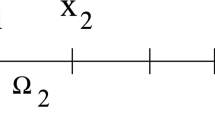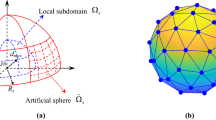Abstract
A new fast direct linear equation solver for the boundary element method (BEM) is presented in this paper. The idea of the new fast direct solver stems from the concept of the hierarchical off-diagonal low-rank matrix. The hierarchical off-diagonal low-rank matrix can be decomposed into the multiplication of several diagonal block matrices. The inverse of the hierarchical off-diagonal low-rank matrix can be calculated efficiently with the Sherman–Morrison–Woodbury formula. In this paper, a more general and efficient approach to approximate the coefficient matrix of the BEM with the hierarchical off-diagonal low-rank matrix is proposed. Compared to the current fast direct solver based on the hierarchical off-diagonal low-rank matrix, the proposed method is suitable for solving general 3-D boundary element models. Several numerical examples of 3-D potential problems with the total number of unknowns up to above 200,000 are presented. The results show that the new fast direct solver can be applied to solve large 3-D BEM models accurately and with better efficiency compared with the conventional BEM.











Similar content being viewed by others
References
Brebbia CA, Dominguez J (1994) Boundary elements: an introductory course. WIT Press, Ashurst
Banerjee P, Butterfield R (1994) The boundary element methods in engineering. McGraw-Hill, New York
Bonnet M (1999) Boundary integral equation methods for solids and fluids. Meccanica 34(4):301–302. doi:10.1023/a:1004795120236
Aliabadi M (2002) The boundary element method: applications in solids and structures, vol 2. Wiley, Chicester
Mukherjee S, Mukherjee YX (2005) Boundary methods: elements, contours, and nodes. CRC Press, Boca Raton
Liu YJ (2009) Fast multipole boundary element method—theory and applications in engineering. Cambridge University Press, Cambridge
Rokhlin V (1985) Rapid solution of integral-equations of classical potential-theory. J Comput Phys 60(2):187–207
Greengard L, Rokhlin V (1987) A fast algorithm for particle simulations. J Comput Phys 73(2):325–348
Shen L, Liu YJ (2007) An adaptive fast multipole boundary element method for three-dimensional potential problems. Comput Mech 39(6):681–691
Liu YJ, Shen L (2007) A dual BIE approach for large-scale modeling of 3-D electrostatic problems with the fast multipole boundary element method. Int J Numer Meth Eng 71(7):837–855. doi:10.1002/nme.2000
Bapat MS, Liu YJ (2010) A new adaptive algorithm for the fast multipole boundary element method. Comput Model Eng Sci 58(2):161–184
Liu YJ, Nishimura N, Otani Y, Takahashi T, Chen XL, Munakata H (2005) A fast boundary element method for the analysis of fiber-reinforced composites based on a rigid-inclusion model. J Appl Mech 72(1):115–128. doi:10.1115/1.1825436
Liu YJ (2006) A new fast multipole boundary element method for solving large-scale two-dimensional elastostatic problems. Int J Numer Meth Eng 65(6):863–881. doi:10.1002/nme.1474
Liu YJ (2008) A fast multipole boundary element method for 2D multi-domain elastostatic problems based on a dual BIE formulation. Comput Mech 42(5):761–773. doi:10.1007/s00466-008-0274-2
Shen L, Liu YJ (2006) An adaptive fast multipole boundary element method for three-dimensional acoustic wave problems based on the burton-miller formulation. Comput Mech 40(3):461–472. doi:10.1007/s00466-006-0121-2
Bapat MS, Shen L, Liu YJ (2009) Adaptive fast multipole boundary element method for three-dimensional half-space acoustic wave problems. Eng Anal Boundary Elem 33(8–9):1113–1123. doi:10.1016/j.enganabound.2009.04.005
Wu HJ, Liu YJ, Jiang WK (2012) Analytical integration of the moments in the diagonal form fast multipole boundary element method for 3D acoustic wave problems. Eng Anal Boundary Elem 36(2):248–254. doi:10.1016/j.enganabound.2011.08.004
Song JM, Chew WC (1995) Multilevel fast-multipole algorithm for solving combined field integral-equations of electromagnetic scattering. Microw Opt Technol Lett 10(1):14–19
Song JM, Lu CC, Chew WC (1997) Multilevel fast multipole algorithm for electromagnetic scattering by large complex objects. IEEE Trans Antennas Propag 45(10):1488–1493
Darve E, Have P (2003) Fast multipole method for low-frequency electromagnetic scattering. In: Proceedings of the computational fluid and solid mechanics 2003, vols 1 and 2, pp 1299–1302
Tsuji P, Ying L (2011) A fast directional algorithm for high-frequency electromagnetic scattering. J Comput Phys 230(14):5471–5487. doi:10.1016/j.jcp.2011.02.013
Nishimura N (2002) Fast multipole accelerated boundary integral equation methods. Appl Mech Rev 55(4):299. doi:10.1115/1.1482087
Liu YJ, Nishimura N (2006) The fast multipole boundary element method for potential problems: a tutorial. Eng Anal Boundary Elem 30(5):371–381. doi:10.1016/j.enganabound.2005.11.006
Liu YJ, Mukherjee S, Nishimura N, Schanz M, Ye W, Sutradhar A, Pan E, Dumont NA, Frangi A, Saez A (2011) Recent advances and emerging applications of the boundary element method. Appl Mech Rev 64(3):1–38. doi:10.1115/1.4005491
Hackbusch W (1999) A sparse matrix arithmetic based on \({\cal{H}}\)-matrices. Part I: introduction to \({\cal{H}}\)-matrices. Computing 62(2):89–108. doi:10.1007/s006070050015
Hackbusch W, Khoromskij BN (2000) A sparse \({\cal{H}}\)-matrix arithmetic. Computing 64(1):21–47
Hackbusch W, Börm S (2002) Data-sparse approximation by adaptive \({\cal{H}}^{2}\)-matrices. Computing 69(1):1–35. doi:10.1007/s00607-002-1450-4
Börm S, Grasedyck L, Hackbusch W (2003) Introduction to hierarchical matrices with applications. Eng Anal Boundary Elem 27(5):405–422
Ambikasaran S (2013) Fast algorithms for dense numerical linear algebra and applications. Stanford University, Stanford
Bebendorf M (2000) Approximation of boundary element matrices. Numer Math 86:565–589
Bebendorf M, Rjasanow S (2003) Adaptive low-rank approximation of collocation matrices. Computing 70:1–24
Bebendorf M, Grzhibovskis R (2006) Accelerating Galerkin BEM for linear elasticity using adaptive cross approximation. Math Methods Appl Sci 29(14):1721–1747. doi:10.1002/mma.759
Smajic J, Andjelic Z, Bebendorf M (2007) Fast BEM for eddy-current problems using h-matrices and adaptive cross approximation. IEEE Trans Magn 43(4):1269–1272. doi:10.1109/tmag.2006.890971
Maaskant R, Mittra R, Tijhuis A (2008) Fast analysis of large antenna arrays using the characteristic basis function method and the adaptive cross approximation algorithm. IEEE Trans Antennas Propag 56(11):3440–3451. doi:10.1109/tap.2008.2005471
Maerten F (2010) Adaptive cross-approximation applied to the solution of system of equations and post-processing for 3D elastostatic problems using boundary element method. Eng Anal Boundary Elem 34:483–491
Saad Y (2003) Iterative methods for sparse linear system, 2nd edn. The Society for Industrial and Applied Mathematics, Philadelphia
Chen K (2005) Matrix preconditioning techniques and applications. Cambridge University Press, Cambridge
Martinsson PG, Rokhlin V (2005) A fast direct solver for boundary integral equations in two dimensions. J Comput Phys 205(1):1–23. doi:10.1016/j.jcp.2004.10.033
Corona E, Martinsson P-G, Zorin D (2015) An o(N) direct solver for integral equations on the plane. Appl Comput Harm Anal 38(2):284–317. doi:10.1016/j.acha.2014.04.002
Greengard L, Gueyffier D, Martinsson P-G, Rokhlin V (2009) Fast direct solvers for integral equations in complex three-dimensional domains. Acta Numer 18:243–275
Ho KL, Greengard L (2012) A fast direct solver for structured linear systems by recursive skeletonization. SIAM J Sci Comput 34(5):A2507–A2532
Lai J, Ambikasaran S, Greengard LF (2014) A fast direct solver for high frequency scattering from a large cavity in two dimensions. SIAM J Sci Comput 36(6):B887–B903
Ambikasaran S, Darve E (2013) An \(\text{ O }(N\text{ log }N)\) fast direct solver for partial hierarchically semi-separable matrices. J Sci Comput 57(3):477–501. doi:10.1007/s10915-013-9714-z
Coulier P, Pouransari H, Darve E (2015) The inverse fast multipole method: using a fast approximate direct solver as a preconditioner for dense linear systems. arXiv preprint arXiv:1508.01835
Sherman J, Morrison WJ (1950) Adjustment of an inverse matrix corresponding to a change in one element of a given matrix. Ann Math Stat 21(1):124–127
Woodbury MA (1950) Inverting modified matrices. https://en.wikipedia.org/wiki/Woodbury_matrix_identity
Woolfe F, Liberty E, Rokhlin V, Tygert M (2008) A fast randomized algorithm for the approximation of matrices. Appl Comput Harmon Anal 25(3):335–366. doi:10.1016/j.acha.2007.12.002
Liberty E, Woolfe F, Martinsson PG, Rokhlin V, Tygert M (2007) Randomized algorithms for the low-rank approximation of matrices. Proc Nat Acad Sci USA 104(51):20167–20172. doi:10.1073/pnas.0709640104
Martinsson P-G, Rokhlin V, Tygert M (2011) A randomized algorithm for the decomposition of matrices. Appl Comput Harmon Anal 30(1):47–68. doi:10.1016/j.acha.2010.02.003
Halko N, Martinsson PG, Tropp JA (2011) Finding structure with randomness: probabilistic algorithms for constructing approximate matrix decompositions. SIAM Rev 53(2):217–288. doi:10.1137/090771806
Nabors K, White J (1991) Fastcap: a multipole accelerated 3-D capacitance extraction program. IEEE Trans Comput Aided Des Integr Circuits Syst 10(11):1447–1459
Phillips JR, White JK (1997) A precorrected-FFT method for electrostatic analysis of complicated 3-d structures. IEEE Trans Comput Aided Des Integr Circuits Syst 16(10):1059–1072
Author information
Authors and Affiliations
Corresponding author
Rights and permissions
About this article
Cite this article
Huang, S., Liu, Y.J. A new fast direct solver for the boundary element method. Comput Mech 60, 379–392 (2017). https://doi.org/10.1007/s00466-017-1407-2
Received:
Accepted:
Published:
Issue Date:
DOI: https://doi.org/10.1007/s00466-017-1407-2




